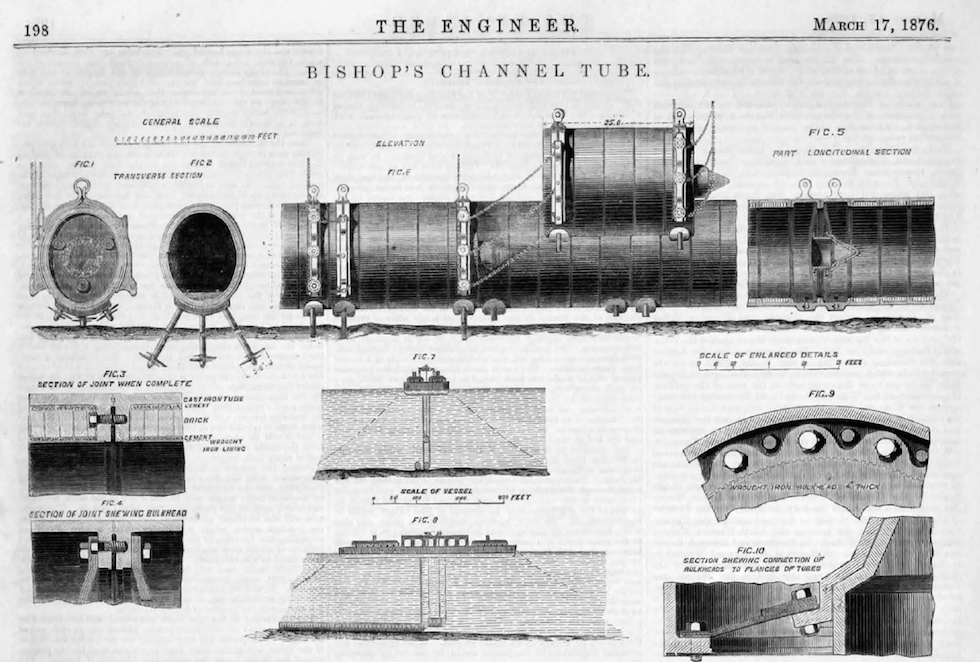Despite the almost ever-present tension, plans to connect the UK to mainland Europe have been around for centuries. In March 1876, The Engineer compiled an extensive roundup of the various means that could be employed to accomplish the task, including tunnels, tubes, and bridges. According to that same edition of the publication, proposals to create a link between Britain and France go as far back as 1802, just as the Napoleonic Wars were getting underway.
“Ever since the commencement of the present century there has been evinced a very firmly rooted conviction that there ought to be a line of communication established between England and the Continent of Europe other than that afforded by the passage of steamships between shore and shore,” our predecessors wrote in 1876.
“The first proposition to unite England and France was made in 1802, by Monsieur Mathieu, whose plans were laid before the First Napoleon, then First Consul, and were afterwards exhibited at the Luxembourg and public galleries in Paris. They have, however, long since been lost, and with them the proposed method of carrying out the work.”
Another Frenchman is singled out for special praise by The Engineer for his lifelong dedication to the project. Known today as the “father of the tunnel”, Monsiuer Thomé de Gamond died just a month prior to the 1876 article’s publication. He devoted more than 40 years of his engineering career to researching a tunnel under the Straits of Dover, his “scientific attainments” and “irreproachable character” winning him “the love of many and the regard of all.”
Throughout the course of his work M. de Gamond made over 1,500 experimental borings in France and England to examine the strata, as well as carrying out three dives to the bottom of the channel to examine the contents of its bed. The last of these dives saw him “attacked by conger eels or dogfish”, resulting in serious injuries. Though he didn’t get to witness his vision become reality, M. de Gamond did live to see his idea for a channel tunnel be “adopted by eminent engineers in both countries, and supported by financial authorities.”
Those eminent engineers would include Sir John Hawkshaw and Sir James Brunlees, founders of the original Channel Tunnel Company in 1872. They proposed a tunnel of 31 miles between St Margaret’s Bay in England to a point on the French coast roughly midway between Calais and Sangatte.
This line was chosen to take the tunnel entirely through the lower chalk, assumed at the time to be homogenous. Although undoubtedly a serious challenge, it was certainly one that was technically possible, according to The Engineer.
“For the execution of the work, as far as mechanical aid is concerned, there need be no apprehension, there now being ample means in the way of tunnelling machinery, and ample experience in its extensive use.”
“The tunnel will be a single one of circular or of the ordinary tunnel section, the chalk boring being 36ft in diameter at the arch springing, and when lined with brickwork in cement it will have an interior diameter of 30ft.”
While our predecessors declared that “preliminary operations will shortly be commenced,” we of course know now that Brunlees and Hawkshaw’s particular endeavour would never be attempted, and the Channel Tunnel would not be completed until over a century later.

Another intriguing concept from the time that never came to fruition was Bishop’s Channel Tube. As the name suggests, this was a railway tube that sat on top of the seabed rather than boring beneath it. Sections of cast iron lined with bricks and cement, each measuring 25ft and weighing 273 tons, would be lowered to the seabed from a floating pontoon 400ft long by 100ft wide.
Workers on the pontoon would be in electronic communication with those working in the slowly advancing tube. Using glass sight-holes in the tube’s bulkhead, the workers could help guide the iron sections into position. The structure would be protected from the “injurious” effects of the seawater through the application of Calley’s Torbay oxide paint. Looking back, it was certainly an innovative approach, but probably not one that would’ve passed the EU health and safety checks of today. A reminder, perhaps, that Brussels has given rise to good ideas as well as bad.





Hard hat mounted air curtain adds layer of protection
Something similar was used by miners decades ago!